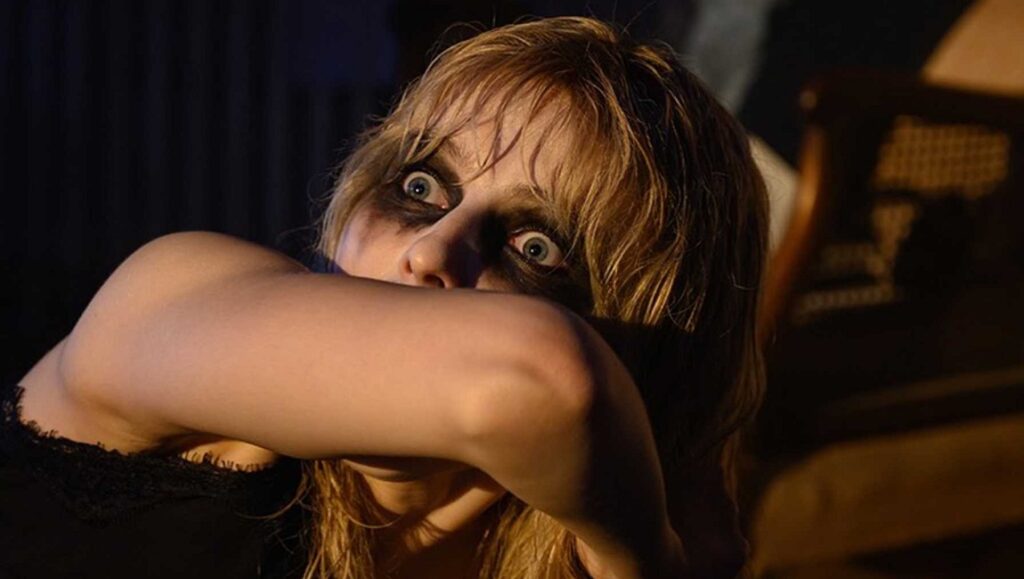Last Night in Soho is a seductive and sumptuous Giallo riff, but suffers from a final act that undermines much of the film’s early power.
Last Night in Soho, the latest flick from Edgar Wright, marks the British director’s first foray into outright horror, departing from his usual twinned comfort zones of action-comedy and parody. Set in Soho, one of London’s seedier districts, his story, co-written with 1917 scribe Krysty Wilson-Cairns, follows Eloise (Thomasin McKenzie), a fashion student moving from Cornwall to London to start her education at a prestigious fashion school. Feeling out of place among her more worldly (read: pretentious) classmates, Eloise moves into a bedsit in Soho, where her dreams provide a window to the world of Sandy (Anya Taylor-Joy), an aspiring singer who seeks to dominate 1960s Soho, with her manager Jack (Matt Smith) at her side. As Sandy’s plans start to go awry, her world begins bleeding into Eloise’s, and the strangers who sought to prey on Sandy seem to have similar designs on Eloise.
Wright’s London is a city of ghosts, and his Soho is no different. Wright finds the horror of Soho in his sometimes funny, sometimes terrifying assertion that every room in the city has had somebody die there and that everybody has a story. The London of Last Night in Soho, full of grit and glamour in equal measure, is a place where people can easily slip through the cracks, a place that preys on young women, and where smiles from strangers can turn into snarls all too quickly. For both Eloise and Sandy, London is as terrifying as it is seductive, and Soho reflects the peak of both, with Wright refusing to ever pretend that Eloise’s nostalgia is for a place that actually existed. For Wright, there are no good old days, and all the glamour that Eloise dreams of comes at a price.
But for all this doom and gloom, Last Night in Soho is still remarkably playful. As usual, Wright’s affinity for popular music needle drops lends a slick sense of fun to the film, with dozens of ’60s hits littering the soundtrack and providing yet another link between present and past. Importantly, the greatest hits curation here resists ever becoming one-note, with Taylor-Joy’s rendition of Petula Clark’s “Downtown” and a frantic montage set to “Land of A Thousand Dances” specifically both providing an unsettling backdrop to Wright’s horror. Similarly, cinematographer Chung-hoon Chung lets loose, ripping pages out of the Giallo textbook. To fans of “elevated horror” (a term that should be taken out back and shot), Chung’s efforts might look like they’re following the pervasive trend of dual-color lighting, but for more initiated horror aficionados, drenching Anya Taylor-Joy in neons is just one of the loving homages to the resurgent Giallo style. Wright also deftly borrows the subgenre’s inclination toward mystery and its focus on what the BFI describes as “the physical and psychological dismemberment of beautiful women.” The result is a gleefully self-indulgent riot of color, replete with Wright’s signature flashy editing (particularly in a scene set in the Cafe de Paris, where Eloise meets Jack and Sandy for the first time), that makes for a visual feast, although absent of the sharper darkness that really could have helped the horror elements land more expertly. Wright veers more toward the safety of hyper-style and away from the genre’s deep psychosexual core, losing some of Giallo’s essential character in translation. Instead, Wright aims for a vaguely more feminist film, which despite being admirable in intent and a sneaky subversion of the Italian subgenre, somewhat neuters the horror of the film.
All these stylistic flourishes are anchored not by Wright and Wilson-Cairns’ script, but by three incredible central performances from Taylor-Joy, McKenzie, and Smith. Despite not having all that much screentime, Smith flits between charm and menace with alarming speed, providing a face for the very real danger that Wright often leaves faceless. Taylor-Joy, meanwhile, is a predictably magnetic presence, and Wright allows her to shine as Sandy, with her physicality as an actor finally given ample room to thrive. Her unique presence enhances the bright costuming choices of Odile Dicks-Mireaux, who manages to maintain the film’s wash of colors even in its darkest moments by working ingeniously with textures, ranging from the diaphanous coral dress of Eloise’s fantasies to synthetic, plasticky fabrics that ably communicate Sandy’s skin-thickening as her reality becomes harsher. And Taylor-Joy works in perfect tandem with McKenzie, who admirably holds her own against the former’s outsized presence. Eloise’s earnest adoration and protectiveness over Sandy operates as the lynchpin of the entire film, and McKenzie presents a deep emotional core that keeps the Soho dream sequences from becoming detached from the film’s present-day narrative.
What’s perhaps most disappointing, then, is that McKenzie and Taylor-Joy do such good work building up this genuinely touching dynamic only for Wright and Wilson-Cairns to blow it up at the last minute. An eleventh-hour effort to pitch the film as subversively feminist fails, and the pivot botches the third act in a way that, for some, may inevitably ruin all the good work put in beforehand (which is a real shame, given just how excellent the first two acts of the film are). For this critic, the third act letdown isn’t enough to fully sink what is otherwise a deeply enjoyable horror film built around singular, rhapsodic visuals, but even though Last Night in Soho succeeds as seductive spectacle, Wright ultimately isn’t quite brave enough to fully indulge the seedy.


Comments are closed.